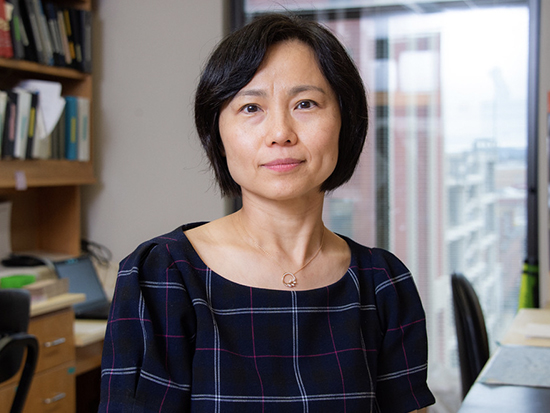

Qin Wang, M.D., Ph.D., professor in the Department of Cell, Developmental and Integrative Biology, is the latest winner of the School of Medicine’s Featured Discovery. This initiative celebrates important research from School of Medicine faculty members.
Wang’s study “β-amyloid redirects norepinephrine signaling to activate the pathogenic GSK3β/tau cascade,” was recently published in Science Translational Medicine. She collaborated with other members of the Department of Cell, Developmental and Integrative Biology on this study, as well as colleagues from the Department of Genetics, Department of Microbiology, and the Department of Neurology.
Wang discovered a key piece of research on Alzheimer’s disease. Proof-of-concept experiments, using an existing drug called idazoxan, dramatically reduced Alzheimer’s pathology and symptoms in two animal models, possibly presenting an immediate treatment. Idazoxan is an alpha-2A adrenergic receptor antagonist that has been under investigation in clinical trials for depression. The hypothesis was that idazoxan blockage of alpha-2A adrenergic receptor in the presence of amyloid-beta pathology would show therapeutic potential. This data demonstrates that blocking norepinephrine signaling through the alpha-2A adrenergic receptor is an effective strategy to improve cognitive deficits associated with amyloid-beta. Conclusively, the study provided translational insights into mechanisms underlying amyloid-beta protein toxicity. It identified an amyloid-beta/G protein-coupled receptor interaction signifying an attractive, disease-specific therapeutic target for Alzheimer’s disease.
This knowledge is important for research, clinical data, and potential treatments for patients with Alzheimer’s disease. Read more about Dr. Wang's study from UAB News here.
The School of Medicine communications staff sat down with Dr. Wang to gain insights about her research, UAB, and the science community.
Q: What compelled you to pursue this research?
My expertise lies in neuropharmacology and signaling. My lab research has an interest in deciphering cell surface receptor signaling in the brain and uncovering their contributions to pathological changes in neurological and psychiatric diseases. Our primary goal is to translate our bench discoveries to preclinical and clinical tests. Alzheimer’s disease (AD) is a devastating disease that affects millions of people, yet has no cure. There is so much unknown about the etiology of this disease.
Q: What was your most unexpected finding?
Our study revealed a direct etiological role of norepinephrine in AD pathogenesis. Norepinephrine is well known to promote cognitive function, and neurons that produce and release this neurotransmitter are highly sensitive targets of amyloid and tau toxicity. We found that norepinephrine connects amyloid beta to pathological change of tau, providing a novel route for Abeta to initiate the disease process. This was totally unexpected.
Q: How do you feel your research will impact the science community?
Our study advanced fundamental understanding of AD pathogenesis. We discovered a new mechanism linking amyloid beta to tau, which has strong implications in our understanding of the failed clinical trials that directly target amyloid clearance. Also, our research opened up a new direction for developing effective strategies to treat AD.
Q: What is your research’s relevance to human disease?
This study is highly relevant to Alzheimer’s disease. Our preclinical studies demonstrated that blocking norepinephrine signaling effectively mitigates AD-related pathological and cognitive deficits.
Q: How has being at UAB and living in Birmingham affected your research?
UAB has been a great place for research. Collaboration is key for success in research. We received tremendous support from our colleagues at UAB on our study. Drs. Erik Roberson, Bingdong Sha and Kai Jiao have been actively involved in this project, helping us on critical experiments and giving us critical inputs and suggestions. We are very grateful to the collaborative environment at UAB.